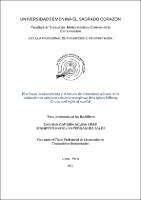| dc.contributor.advisor | Aguilar Benites, José Humberto | |
| dc.contributor.advisor | Soriano Vergara, Rossana | |
| dc.contributor.author | Acuña Orbe, Dayana Carmen | |
| dc.contributor.author | Fernández Salés, Jenniffer Karolyn | |
| dc.date.accessioned | 2016-11-07T06:55:00Z | |
| dc.date.available | 2016-11-07T06:55:00Z | |
| dc.date.issued | 2015 | |
| dc.identifier.uri | http://hdl.handle.net/20.500.11955/205 | |
| dc.description.abstract | La traducción de canciones es una tarea que demanda al traductor no sólo hacer uso de su conocimiento para traducir el contenido del texto y el significado de sus palabras, sino también el ritmo de esas, lo que el autor desea transmitir con la canción, la melodía y el número de silabas que componen el texto. Se debe tener en cuenta si la traducción de la canción es solo para lectura o va a ser cantada en el idioma meta. El traductor, también, deberá tener un conocimiento, al menos básico, de música, incluyendo la partitura y el ritmo. El traducir canciones religiosas, tema que se analiza en la presente investigación, nos lleva a prestar atención a dos enfoques presentes en este tipo de traducciones, el logocentrismo y el musicocentrismo, que se inclinan por dar mayor importancia al mensaje y a la música respectivamente. En este caso lo que se busca es llegar a un público masivo, que se identifique con las canciones, que las reconozca y que se familiarice rápidamente. El traductor, entonces, debe considera la música como aspecto fundamental al momento de traducir. Para esto se presentan cuatro métodos de traducción que consideran el número de sílabas de la frase musical en ambas versiones así como la posición de los acentos musicales. La investigación establecerá el enfoque con mayor incidencia en la traducción de las canciones religiosas de la iglesia Hillsong Church así como el método de traducción utilizado al momento de realizar las traducciones. Para esto se realizará un análisis de ambas versiones, origen y meta, considerando no solo el mensaje, sino también la música de las canciones. | es_PE |
| dc.description.abstract | Song translation is a task that requires for a translator not only to use his knowledge to translate the text’s content and the meaning of words; but also the rhythm, what he author wants to communicate with the song, the medoly and the number of syllables in the text. He also has to consider if the song translation is just for reading or it is going to be sing in the target language. The translator must also have music knowledge, at least the basics, including sheet music and rhythm. The translation of religious song, subject that is analyzed in this research, makes us pay attention to two approaches that are present in this type of translations, logocentrism and musicocentrism, that give more importance to the message and the music, respectively. In this case the target is a massive audience that will identify with the songs, will recognize them and get familiar with tems easily . The translator, then, must consider music as a main aspect when translating. For this purpose there are four translation methods that consider the number of syllables in the phrase in both versions, as well as the position of accents. The research will establish the approach with greater impact in the translation of the religious songs of Hillsong Church, as well as the translation method used when translating. In order to do this, an analysis of both versions will be made, source and target, considering not only the message, but song´s music as well. | es_PE |
| dc.description.uri | Tesis | |
| dc.format | application/pdf | es_PE |
| dc.language.iso | spa | es_PE |
| dc.publisher | Universidad Femenina del Sagrado Corazón | es_PE |
| dc.rights | info:eu-repo/semantics/closedAccess | es_PE |
| dc.rights.uri | https://creativecommons.org/licenses/by-nc-nd/4.0/ | es_PE |
| dc.source | Repositorio Institucional - UNIFÉ | |
| dc.subject | Traducción e interpretación | |
| dc.subject | Canciones sacras | |
| dc.subject | Traducción--Tesis | |
| dc.title | El enfoque musicocentrista y el método del mimetismo aplicado en la traducción de canciones cristiano-evangélicas de la iglesia Hillsong Church del inglés al español | es_PE |
| dc.type | info:eu-repo/semantics/bachelorThesis | es_PE |
| thesis.degree.name | Licenciada en Traducción e Interpretación | es_PE |
| thesis.degree.grantor | Universidad Femenina del Sagrado Corazón. Facultad de Traducción, Interpretación y Ciencias de la Comunicación | es_PE |
| thesis.degree.level | Título Profesional | es_PE |
| thesis.degree.discipline | Traducción e Interpretación | es_PE |
| dc.subject.ocde | https://purl.org/pe-repo/ocde/ford#6.02.01 | es_PE |
| renati.advisor.dni | 08847304 | |
| renati.advisor.dni | 07305103 | |
| renati.advisor.orcid | https://orcid.org/0000-0001-8078-1342 | es_PE |
| renati.author.dni | 43453171 | |
| renati.author.dni | 40941233 | |
| renati.discipline | 231126 | es_PE |
| renati.level | https://purl.org/pe-repo/renati/level#tituloProfesional | es_PE |
| renati.type | https://purl.org/pe-repo/renati/type#tesis | es_PE |
| dc.publisher.country | PE | es_PE |


